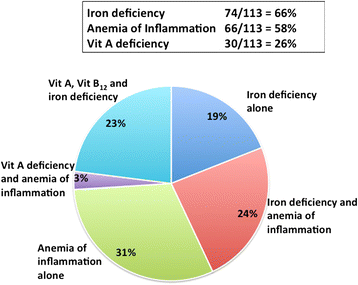Anemia, diet and therapeutic iron among children living with HIV: a prospective cohort study
- PMID: 26482352
- PMCID: PMC4612411
- DOI: 10.1186/s12887-015-0484-7
Anemia, diet and therapeutic iron among children living with HIV: a prospective cohort study
Abstract
Background: Children living with HIV have higher-than-normal prevalence of anemia. The beneficial effect of therapeutic iron has been questioned in the setting of high prevalence of infections. This study examines anemia prevalence and effect of standard therapeutic iron on HIV disease progression among children.
Methods: Perinatally-infected children aged 2-12 years were enrolled at three sites in southern India, and were followed for 1 year with clinical assessments, dietary recall and anthropometry. Laboratory parameters included iron markers (ferritin, soluble transferrin receptor) and other micronutrient levels (vitamin A, B12, folate). Iron was given to anemic children based on WHO guidelines. Statistical analyses including frequency distributions, chi square tests and multivariate logistic regression were performed using Stata v13.0.
Results: Among 240 children enrolled (mean age 7.7 years, 54.6% males), median CD4 was 25%, 19.2% had advanced disease, 45.5% had malnutrition, and 43.3% were on antiretroviral treatment (ART) at baseline. Anemia was prevalent in 47.1% (113/240) children. Iron deficiency was present in 65.5%; vitamin A and vitamin B12 deficiency in 26.6% and 8.0% respectively; and anemia of inflammation in 58.4%. Independent risk factors for anemia were stunting, CD4 < 25%, detectable viral load ≥ 400 copies/ml and vitamin A deficiency. Inadequate dietary iron was prominent; 77.9% obtained less than two-thirds of recommended daily iron. Among clinically anemic children who took iron, overall adherence to iron therapy was good, and only minor self-limiting adverse events were reported. Median hemoglobin rose from 10.4 g/dl to 10.9 mg/dl among those who took iron for 3 months, and peaked at 11.3 mg/dl with iron taken for up to 6 months. Iron was also associated with a greater fall in clinical severity of HIV stage; however when adjusted for use of ART, was not associated with improvement in growth, inflammatory and CD4 parameters.
Conclusions: Children living with HIV in India have a high prevalence of anemia mediated by iron deficiency, vitamin A deficiency and chronic inflammation. The use of therapeutic iron for durations up to 6 months appears to be safe in this setting, and is associated with beneficial effects on anemia, iron deficiency and HIV disease progression.
Figures
Similar articles
-
The prevalence and etiology of anemia among HIV-infected children in India.Eur J Pediatr. 2012 Mar;171(3):531-40. doi: 10.1007/s00431-011-1599-y. Epub 2011 Oct 19. Eur J Pediatr. 2012. PMID: 22009132
-
Examining Associations of HIV and Iron Status with Nutritional and Inflammatory Status, Anemia, and Dietary Intake in South African Schoolchildren.Nutrients. 2021 Mar 16;13(3):962. doi: 10.3390/nu13030962. Nutrients. 2021. PMID: 33809705 Free PMC article.
-
Maternal anemia and preterm birth among women living with HIV in the United States.Am J Clin Nutr. 2021 Jun 1;113(6):1402-1410. doi: 10.1093/ajcn/nqaa441. Am J Clin Nutr. 2021. PMID: 35104854 Free PMC article.
-
[Review by expert group in the diagnosis and treatment of anemia in pregnant women. Federación Mexicana de Colegios de Obstetricia y Ginecología].Ginecol Obstet Mex. 2012 Sep;80(9):563-80. Ginecol Obstet Mex. 2012. PMID: 23243836 Spanish.
-
Home fortification of foods with multiple micronutrient powders for health and nutrition in children under two years of age (Review).Evid Based Child Health. 2013 Jan;8(1):112-201. doi: 10.1002/ebch.1895. Evid Based Child Health. 2013. PMID: 23878126 Review.
Cited by
-
Magnitude and Factors Associated with Cytopenia Among Children on Highly Active Antiretroviral Therapy at Hawassa University College of Medicine and Health Science, Sidama Region, Southern Ethiopia.HIV AIDS (Auckl). 2023 Apr 1;15:145-155. doi: 10.2147/HIV.S403923. eCollection 2023. HIV AIDS (Auckl). 2023. PMID: 37033890 Free PMC article.
-
Iron status among HIV-infected adults during the first year of antiretroviral therapy in Tanzania.HIV Med. 2023 Apr;24(4):398-410. doi: 10.1111/hiv.13396. Epub 2022 Sep 8. HIV Med. 2023. PMID: 36075691 Free PMC article.
-
Magnitude of cytopenias among HIV-infected children in Bahir Dar, northwest Ethiopia: a comparison of HAART-naïve and HAART-experienced children.HIV AIDS (Auckl). 2017 Feb 20;9:31-42. doi: 10.2147/HIV.S125958. eCollection 2017. HIV AIDS (Auckl). 2017. PMID: 28260948 Free PMC article.
-
Predictors of Anemia Among HIV-Infected Children on Antiretroviral Therapy in Wolaita Zone, South Ethiopia: A Facility-Based Cross-Sectional Study.HIV AIDS (Auckl). 2021 Jan 8;13:13-19. doi: 10.2147/HIV.S282845. eCollection 2021. HIV AIDS (Auckl). 2021. PMID: 33447087 Free PMC article.
-
Determinates of anemia among Human Immune Deficiency Virus positive children on Anti-retro Viral Therapy in selected health facilities, Northwest Ethiopia: A Case-Control Study.J Nutr Sci. 2023 Aug 30;12:e95. doi: 10.1017/jns.2023.79. eCollection 2023. J Nutr Sci. 2023. PMID: 37706072 Free PMC article.
References
-
- Mwiru RS, Spiegelman D, Duggan C, Seage GR, 3rd, Semu H, Chalamilla G, Kisenge R, Fawzi WW. Nutritional Status and Other Baseline Predictors of Mortality among HIV-Infected Children Initiating Antiretroviral Therapy in Tanzania. J Int Assoc Prov AIDS Care. 2015;14(2):172–9. doi: 10.1177/2325957413500852. - DOI - PMC - PubMed
Publication types
MeSH terms
Substances
Grants and funding
LinkOut - more resources
Full Text Sources
Other Literature Sources
Medical
Research Materials


